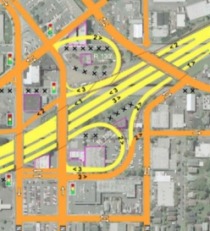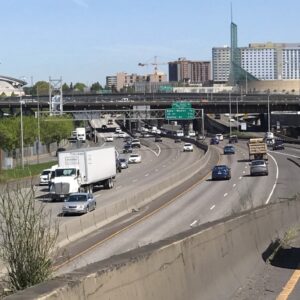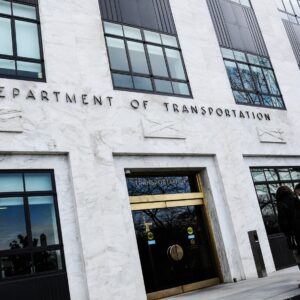
(Photo © J. Maus)
Tonight at ODOT headquarters in Northwest Portland, City and state transportation officials will host a public meeting to discuss how to best improve the transportation system around the I-5/Broadway/Weidler interchange near the Rose Quarter.
The event is part of the N/NE Quadrant Project, a “unique collaboration” between ODOT and PBOT to, “ensure a vibrant Central City at the heart of the metropolitan region.”
Currently, this area is anything but vibrant. It is marked by wide and fast roads which — partly due to Eastside Streetcar Loop project construction — are often gridlocked. The presence of I-5, several on/off-ramps and arterial streets also contribute to a very dangerous and uncomfortable environment for road users — especially if you are not protected inside a steel vehicle.

ODOT tried to solve the problems
of I-5 near the Rose Quarter.
Tonight’s workshop (a.k.a. a “charrette”) kicks off a three-day event designed to introduce the transportation problems in the area and glean feedback from the community about how to solve them.
When thinking about this project, it’s important to know that ODOT and PBOT have been studying I-5 in this location since the ’80s. Back in December I shared plans they drew up back in 2007 (but had never been seen by the public) that showed their intentions for solving the issues in this area by simply doing what they’ve always done — widening the freeway and interchanges to move more cars and trucks.
I made my skepticism about how ODOT and PBOT are approaching this project very clear in an editorial on December 15th. How we define the problems on big (potential) projects like this can often play a major role in what solutions we are able to work with. Here’s an excerpt from that editorial:
When I expressed to [PBOT staffer] Iwata my concerns about the dangers inherent in making this report a “starting point” he said, “Your concerns are reflected by several members of our advisory group… Several people are a little suspicious… They see what’s going on with the CRC (Columbia River Crossing)…”
Critics of the CRC are waging a fierce battle in large part because of the way the problem was initially defined. The definition of the problem and the narrative that planners set in the beginning have limited what solutions can be considered; and, some say, favor the solutions the DOTs have wanted to pursue all along.
Iwata told me project staff are approaching this project with a community-based, “bottom-up” style as opposed to the “top-down” style we’ve seen from ODOT and the CRC project. But even with that being said, the “traffic nightmare” rhetoric has already begun and we all know how some traffic engineers like to solve that problem.
Consider the official summary of the agenda: “Discuss charrette purpose and process and begin brainstorming freeway improvement ideas.” Does that sound like they are taking an objective, mode-neutral approach to this process?
This area is a key hub in our transportation system. It includes several very dangerous and broken intersections that have caused numerous bike crashes over the years. It simply must be improved. I just hope PBOT and ODOT realize that we can’t build our way out of congestion.
The first of three workshops sessions will be held tonight from 5:00 to 8:30 pm at ODOT headquarters (123 NW Flanders). Learn more about the project here.






Thanks for reading.
BikePortland has served this community with independent community journalism since 2005. We rely on subscriptions from readers like you to survive. Your financial support is vital in keeping this valuable resource alive and well.
Please subscribe today to strengthen and expand our work.
Why not just remove the freeway entrance and exit ramp there? There are enough close proximity entrances and exits to the Rose Quarter that I don’t think these will be missed.
I made this same point extensively at tonight’s charrette. If you feel like taking this idea a step further, email me: now -at- intersection911.org — thanks!
More and more I think the case can be made that freeways just don’t make sense in an urban context. Freeways are designed to allow non-stop movement at high speeds. This works best in places that have a lot of space between few destinations. Cities are the opposite of this – they have many destinations in a relatively small amount of space.
Maybe I’m primed to notice it, but it seems like this sentiment has been popping up a lot lately, like in this story by Elly Blue: http://www.grist.org/biking/2011-03-14-tearing-down-urban-freeways-to-make-room-for-a-new-bicycle-econ. And this video by Streetfilms: http://www.streetfilms.org/mba-highway-removal/. And there were a few other more mainstream articles on the topic, in the CSM, NPR, and Slate (or Salon; I always get those two mixed up).
Maybe the freeways built in the middle of the last century are reaching their expiration date, and that’s why they’re now being viewed with a critical eye.
Or maybe amid all the news about how cash-strapped we are, the notion of paying – in the case of this Broadway project – a billion (a.k.a. a thousand million) dollars for improvements to a highway interchange (a.k.a a big, swirly, tangly intersection) seems particularly worthy of scrutiny.
Whatever the reason for it happening now, there’s never a bad time to examine with a critical eye the insanely expensive endeavor of cramming suburban highway design into an urban context, and the insanely expensive interchanges this endeavor produces. And to ask: wouldn’t just a regular urban road, with just regular intersections (and even the occasional stop light) work better in a city?
Save the Flint Street bridge!
Every single urban freeway interchange in Portland is a safety hazard for cyclists and pedestrians, and I have very little confidence that traffic engineers have the necessary skills or political backing to make these areas safer for cyclists and pedestrians.
Spencer is spot on. And any urban planner will tell you that as long as the Rose Quarter is cut off from adjacent neighborhoods by I-5 is will fail to develop to its potential. Freeways killed half a dozen city neighborhoods and continue to cast a pall.
Um, how about
* Transportation Demand Management
* Speed limit reduction to 40 to reduce severity of crashes
* Improvements in bike infrastructure to bypass the area for bikes (connect Flint and Weidler, for instance).
* Increase transit service systemwide to provide better alternatives to driving alone.
Ted Buehler
can’t make the meeting…
Increase the gridlock. That’s the solution, from my point of view. It reduces the average speed of traffic to about my speed, which eliminates the speed differential conflict. I can freely move about the idling cars as if time is frozen, and there’s no chance that one can swing into my path, because there’s another metal rolling box in their way.
I really hope Portland’s rush hours continue to grow.